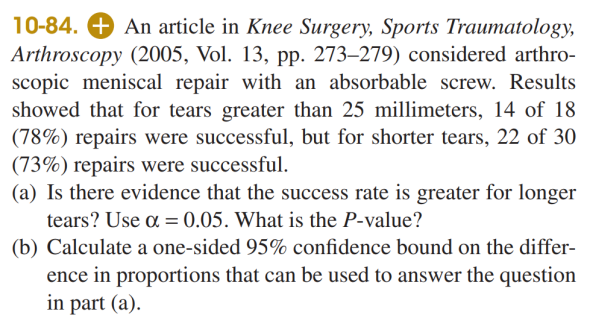10-84. + An article in Knee Surgery, Sports Traumatology, Arthroscopy (2005, Vol. 13, pp. 273–279) considered arthro- scopic meniscal repair with an absorbable screw. Results showed that for tears greater than 25 millimeters, 14 of 18 (78%) repairs were successful, but for shorter tears, 22 of 30 (73%) repairs were successful. (a) Is there evidence that the success rate is greater for longer tears? Use a = 0.05. What is the P-value? %3D (b) Calculate a one-sided 95% confidence bound on the differ- ence in proportions that can be used to answer the question in part (a).
10-84. + An article in Knee Surgery, Sports Traumatology, Arthroscopy (2005, Vol. 13, pp. 273–279) considered arthro- scopic meniscal repair with an absorbable screw. Results showed that for tears greater than 25 millimeters, 14 of 18 (78%) repairs were successful, but for shorter tears, 22 of 30 (73%) repairs were successful. (a) Is there evidence that the success rate is greater for longer tears? Use a = 0.05. What is the P-value? %3D (b) Calculate a one-sided 95% confidence bound on the differ- ence in proportions that can be used to answer the question in part (a).
Linear Algebra: A Modern Introduction
4th Edition
ISBN:9781285463247
Author:David Poole
Publisher:David Poole
Chapter4: Eigenvalues And Eigenvectors
Section4.6: Applications And The Perron-frobenius Theorem
Problem 25EQ
Related questions
Question
Solve the exercise.
(In the other image, this is the correct answer, just to check)
![1) The parameters of interest are the proportion of successes of surgical repairs for different tears, p. and p:
2) H; :
P1 =P2
3) H :
P > P2
4) Test statistic is
where
A1, 1A
=1.65 for a = 0.05
Z905
5) Reject the null hypothesis if z: >
where
6)
18
30
14
22
X2 =
0.73
X1 =
0.78
14 + 22
18 + 30
=0.75
0.78 - 0.73
=0.387
0.75(1- 0.75) 18* 301
7) Conclusion: Because 0.387 < 1.65, we fail to reject the null hypothesis at the 0.05 level of significance.
P-value = [1- P(Z < 0.387)] = 1 - 0.6517 = 0.35
b) 95% confidence interval on the difference:
SP:- P:
0.78(1- 0.78) 0.73(1- 0.73)
(0.78- 0.73) - 1.65,
Sp- P:
18
30
- 0.159 sp. - P:
Because this interval contains the value zero, there is not enough evidence to conclude that the success rate p, exceeds](/v2/_next/image?url=https%3A%2F%2Fcontent.bartleby.com%2Fqna-images%2Fquestion%2F5bb23c15-fa55-4a44-a38c-70b9f9b8bce7%2Fe58626db-7ebe-4e4d-9a94-9210a8326f76%2Fwgtyqrd_processed.png&w=3840&q=75)
Transcribed Image Text:1) The parameters of interest are the proportion of successes of surgical repairs for different tears, p. and p:
2) H; :
P1 =P2
3) H :
P > P2
4) Test statistic is
where
A1, 1A
=1.65 for a = 0.05
Z905
5) Reject the null hypothesis if z: >
where
6)
18
30
14
22
X2 =
0.73
X1 =
0.78
14 + 22
18 + 30
=0.75
0.78 - 0.73
=0.387
0.75(1- 0.75) 18* 301
7) Conclusion: Because 0.387 < 1.65, we fail to reject the null hypothesis at the 0.05 level of significance.
P-value = [1- P(Z < 0.387)] = 1 - 0.6517 = 0.35
b) 95% confidence interval on the difference:
SP:- P:
0.78(1- 0.78) 0.73(1- 0.73)
(0.78- 0.73) - 1.65,
Sp- P:
18
30
- 0.159 sp. - P:
Because this interval contains the value zero, there is not enough evidence to conclude that the success rate p, exceeds

Transcribed Image Text:10-84. + An article in Knee Surgery, Sports Traumatology,
Arthroscopy (2005, Vol. 13, pp. 273–279) considered arthro-
scopic meniscal repair with an absorbable screw. Results
showed that for tears greater than 25 millimeters, 14 of 18
(78%) repairs were successful, but for shorter tears, 22 of 30
(73%) repairs were successful.
(a) Is there evidence that the success rate is greater for longer
tears? Use a = 0.05. What is the P-value?
(b) Calculate a one-sided 95% confidence bound on the differ-
ence in proportions that can be used to answer the question
in part (a).
Expert Solution
This question has been solved!
Explore an expertly crafted, step-by-step solution for a thorough understanding of key concepts.
This is a popular solution!
Trending now
This is a popular solution!
Step by step
Solved in 2 steps with 2 images

Recommended textbooks for you

Linear Algebra: A Modern Introduction
Algebra
ISBN:
9781285463247
Author:
David Poole
Publisher:
Cengage Learning

Linear Algebra: A Modern Introduction
Algebra
ISBN:
9781285463247
Author:
David Poole
Publisher:
Cengage Learning